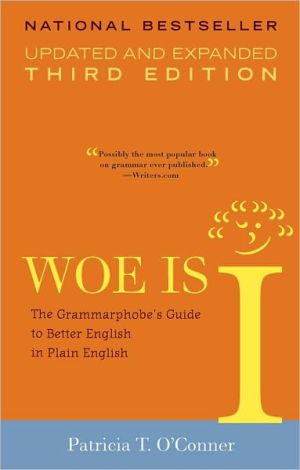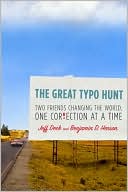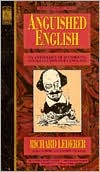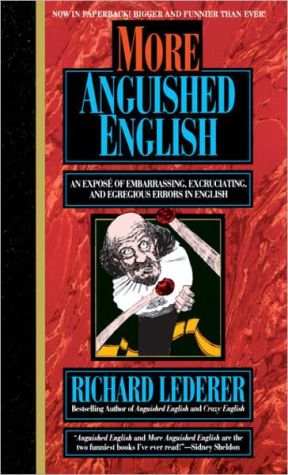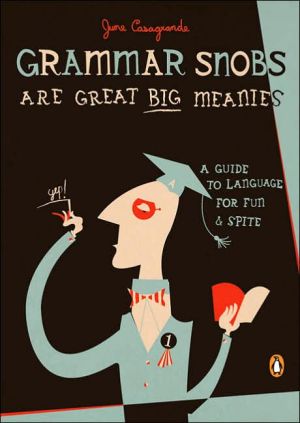Woe Is I: The Grammarphobe's Guide to Better English in Plain English
In this new edition of Woe Is I, Patricia T. O’Conner unties the knottiest grammar tangles and displays the same lively humor that has charmed and enlightened grateful readers for years. With new chapters on spelling and punctuation, and fresh insights into the rights, wrongs, and maybes of English grammar and usage, Woe Is I offers down-to-earth explanations and plain-English solutions to the language mysteries that bedevil all of us:\ \ Avoid the persistent (and persistently embarrassing)...
Search in google:
A witty and therefore easy-to-read look at the rules of grammar. This is truly a fun book to read, which is pretty astounding, given its subject. Daniel Pinkwater Lighthearted and funny...It's like Strunk and White combined with S.J. Perelman. —The New York Times Book Review
Woe Is I\ The Grammarphobe's Guide to Better English in Plain English \ \ By Patricia T. O'Conner \ Riverhead Books\ Copyright © 2003 Patricia T. O'Conner\ All right reserved. \ ISBN: 1573222526 \ \ \ Chapter One\ Woe Is I \ Therapy for Pronoun Anxiety\ When a tiny word gives you a big headache, it's probably a pronoun.\ Pronouns are usually small (I, me, he, she, it), but they're among the biggest troublemakers in the language. If you've ever been picked on by the pronoun police, don't despair. You're in good company. Hundreds of years after the first Ophelia cried "Woe is me," only a pedant would argue that Shakespeare should have written "Woe is I" or "Woe is unto me." (Never mind that the rules of English grammar weren't even formalized in Shakespeare's day.) The point is that no one is exempt from having his pronouns second-guessed.\ Put simply, a pronoun is an understudy for a noun. He may stand in for "Ralph," she for "Alice," they for "the Kramdens," and it for "the stuffed piranha." Why do we need them? Take the following sentence: Ralph smuggled his stuffed piranha into the Kramdens' apartment, sneaked it out of his jacket, and was slipping it into his wife's curio cabinet, when suddenly Alice walked into their living room, clutched her heart, and screamed, "You get that out of my house!"\ If no one had invented pronouns, here's how that sentence would look: Ralph smuggled Ralph's stuffed piranha into the Kramdens' apartment, sneaked the stuffed piranha out of Ralph's jacket, and was slipping the stuffed piranha into Ralph's wife's curio cabinet, when suddenly Alice walked into the Kramdens' living room, clutched Alice's heart, and screamed, "Ralph, get the stuffed piranha out of Alice's house!"\ See how much time pronouns save?\ Simple substitutions (like his for Ralph's) are easy enough. Things get complicated when a pronoun, like any good understudy, takes on different guises, depending on the roles it plays in the sentence. Some pronouns are so well disguised that you may not be able to tell one from another. Enter that and which; it's and its; who's and whose; who and whom; everybody and nobody; and their, they're, and theirs.\ Now let's round up the usual suspects, as well as a few other shady characters.\ The Which Trials: That or Which?\ Bite on one of these: Nobody likes a dog that bites or Nobody likes a dog which bites.\ If they both sound right, you've been spooked by whiches (the first example is the correct one).\ The old that-versus-which problem haunts everybody sooner or later. Here are two rules to help you figure out whether a clause (a group of words with its own subject and verb) should start with that or which.\ * If you can drop the clause and not lose the point of the sentence, use which. If you can't, use that.\ * A which clause goes inside commas. A that clause doesn't.\ Now let's put the rules to work. Look at these two sentences:\ Buster's bulldog, which had one white ear, won best in show. The dog that won best in show was Buster's bulldog.\ The point of each sentence is that Buster's dog won. What happens when we remove the that or which clause?\ In the first example, the which clause (which had one white ear) is disposable-without it, we still have the gist of the sentence: Buster's bulldog won best in show.\ But in the second example, the that clause (that won best in show) is essential. The sentence misses the point without it: The dog was Buster's bulldog.\ Some people consider which more refined or elegant than that. Not so! In fact, that is more likely to be grammatically correct than which. That's because most of us don't put unessential information in the middle of our sentences, especially when speaking.\ Here's a little memory aid:\ Comma Sense\ Commas, which cut out the fat, Go with which, never with that.\ An Itsy-Bitsy Problem: It's or Its?\ The smaller the word, the handier it is. And it is about as useful as they come. It can stand in for anything-a stuffed piranha, existentialism, the Monroe Doctrine, or buttered toast. It's a very versatile pronoun! But did you notice what just happened? We added an s and got it's-or should that be its? Hmmm. When do you use it's, and when do you use its?\ This is an itsy-bitsy problem that gives lots of intelligent people fits. They go wrong when they assume that a word with an apostrophe must be a possessive, like Bertie's aunt. But an apostrophe can also stand for something that's been omitted (as in contractions, which are run-together words like can't and shouldn't). In this case, it's is short for it is. Plain its is the possessive form. So here's the one and only rule you need:\ l If you can substitute it is, use it's.\ NOTE:It's can also be short for it has. There's more on its versus it's in the chapter on possessives, page 39.\ Who's (or Whose) on First?\ This problem is a first cousin of the one above (which you should look at, if you haven't already). As with it's and its, remember that who's is shorthand for who is, and unadorned whose is the possessive form.\ l If you can substitute who is, use who's.\ NOTE:Who's can also be short for who has. There's more on whose versus who's in the chapter on possessives, page 40.\ You're on Your Own\ "Your our kind of people," reads the hotel marquee. Eek! Let's hope impressionable children aren't looking. The sign should read: "You're our kind of people." You're is short for you are; your is the possessive form.\ l If you can substitute you are, use you're.\ Whom Sweet Whom\ Poor whom! Over the years, wordsmiths from Noah Webster to Jacques Barzun have suggested that maybe we should ditch it altogether and let who do the job of both. Not a bad idea. It's pretty hard to imagine an outraged populace protesting, "Whom do you think you're messing with! Get your hands off our pronouns!" There's no doubt that in everyday speech, whom has lost the battle.\ So has the bell tolled for whom?\ Not quite. Here we are, well into a new millennium, and against all odds, creaky old whom is still with us. With a few minor adjustments, we can get away with dropping it when we speak (I'll show you how on page 9), though even that may raise an eyebrow or two. But since written English is more formal than conversational English, anyone who wants to write correctly will have to get a grip on whom.\ If you want to be absolutely correct, the most important thing to know is that who does something (it's a subject, like he), and whom has something done to it (it's an object, like him). You might even try mentally substituting he or him where who or whom should go: if him fits, you want whom (both end in m); if he fits, you want who (both end in a vowel). Who does something to (at, by, for, from, in, toward, upon, with, etc.) whom. The words in parentheses, by the way, are prepositions, words that "position"-that is, locate-other words. A preposition often comes just before whom, but not always. A better way to decide between who and whom is to ask yourself who is doing what to whom.\ This may take a little detective work. Miss Marple herself might have been stumped by the convolutions of some who or whom clauses (a clause, you'll recall, is a group of words with its own subject and verb). For instance, other words may get in between the subject and the verb. Or the object may end up in front of both the subject and the verb. Here are two pointers to help clear up the mystery, and examples of how they're used.\ * Simplify, simplify, simplify: strip the clause down to its basic subject, verb, and object.\ * Move the words around mentally to make it easier to identify the subject and the object.\ Nathan invited only guys [who or whom] he thought played for high stakes. If you strip the clause of its false clues-the words separating the subject and verb-you end up with who ... played for high stakes. Who did something (played for high stakes), so it's the subject.\ Nathan wouldn't tell Miss Adelaide [who or whom] he invited to his crap game. First strip the sentence down to the basic clause, [who or whom] he invited. If it's still unclear, rearrange the words in your mind: he invited whom. You can now see that whom is the object-he did something to (invited) whom-even though whom comes ahead of both the verb and the subject.\ NOTE:A preposition isn't necessarily followed by whom. It can be followed by a clause that starts with who. Consider this sentence: After the crap game, Nathan was confused about [who or whom] owed him money. Don't be misled by the preposition about; it's one of the false clues mentioned above. Instead, simplify, simplify, simplify, and look for the clause-in this case it's who owed him money. Since who did something (owed him money), it's the subject.\ Object Lessons\ THE ME GENERATION\ These days, anyone who says "It is I" sounds like a stuffed shirt. It wasn't always so. In bygone days, you might have had your knuckles rapped for saying "It's me" instead of "It is I." Your crime? A pronoun following the verb to be, the English teacher insisted, should act like a subject (I, he, she, they) and not an object (me, him, her, them). But language is a living thing, always evolving, and It is I is just about extinct. In all but the most formal writing, some of the fussiest grammarians accept It's me. Most of us find the old usage awkward, though I must admit that I still use "This is she" when someone asks for me on the phone. Old habits die harder than old rules.\ Next time you identify the perp in a police lineup, feel free to point dramatically and say, "That's him, Officer!"\ JUST BETWEEN ME AND I\ Why is it that no one ever makes a mistake like this? You'll be hearing from I.\ It's instinctive to use the correct form (from me) when only a solitary pronoun follows a preposition. (Prepositions-after, as, at, before, between, by, for, from, in, like, on, toward, upon, with, and a slew of others-position other words in the sentence.) But when the pronoun isn't alone, instinct goes down the drain, and grammar with it. So we run into abominations like The odds were against you and I, although no one would dream of saying "against I."\ I wouldn't be at all surprised to learn that the seeds of the I-versus-me problem are planted in early childhood. We're admonished to say, "I want a cookie," not "Me want a cookie." We begin to feel subconsciously that I is somehow more genteel than me, even in cases where me is the right choice-for instance, after a preposition. Trying too hard to be right, we end up being wrong. Hypercorrectness rears its ugly head!\ My guess is that most people who make this mistake do so out of habit, without thinking, and not because they don't know the difference between I and me. If you find yourself automatically putting you and I after a preposition, try this: In your mind, eliminate the other guy, leaving the tricky pronoun (I or me) all by itself. Between you and me, it works.\ NOTE: I can hear a chorus of voices shouting, Wait a minute! Doesn't Shakespeare use I after a preposition in The Merchant of Venice? Antonio tells Bassanio, "All debts are clear'd between you and I, if I might but see you at my death." That's true. But then, we're not Shakespeare.\ More Than Meets the I\ Some of the smartest people I know hesitate at the word than when it comes before a pronoun. What goes next, I or me? he or him? she or her? they or them?\ The answer: All of the above! This is easier than it sounds. Take I and me as examples, since they're the pronouns we use most (egotists that we are). Either one may be correct after than, depending on the meaning of the sentence.\ l Trixie loves spaghetti more than I means more than I do.\ l Trixie loves spaghetti more than me means more than she loves me.\ NOTE:If ending a sentence with than I or than she or than they seems awkward or fussy (particularly in speaking), you might simply add the missing thought: Harry smokes more than they do.\ Continues...\ \ \ \ Excerpted from Woe Is I by Patricia T. O'Conner Copyright © 2003 by Patricia T. O'Conner. Excerpted by permission.\ All rights reserved. No part of this excerpt may be reproduced or reprinted without permission in writing from the publisher.\ Excerpts are provided by Dial-A-Book Inc. solely for the personal use of visitors to this web site. \ \
Preface to the Second EditionAcknowledgmentsIntroduction1 Woe Is I: Therapy for Pronoun Anxiety 12 Plurals Before Swine: Blunders with Numbers 193 Yours Truly: The Possessives and the Possessed 374 They Beg to Disagree: Putting Verbs in Their Place 495 Verbal Abuse: Words on the Endangered List 816 Comma Sutra: The Joy of Punctuation 1337 The Compleat Dangler: A Fish out of Water 1598 Death Sentence: Do Cliches Deserve to Die? 1679 The Living Dead: Let Bygone Rules Be Gone 18110 Saying Is Believing: How to Write What You Mean 19511 E-Mail Intuition: Does Anything Go? 205Glossary 219Bibliography 231Index 233
\ Atlanta Journal-ConstitutionThe best primer on English usage to come along since Strunk and White's The Elements of Style.\ \ \ \ \ Daniel PinkwaterLighthearted and funny...It's like Strunk and White combined with S.J. Perelman. —The New York Times Book Review\ \ \ Garrison KeillorThis is, like, a cool book...\ \ \ \ \ Publishers WeeklyStarred Review. \ Former New York Times Book Review editor and linguistic expert O'Conner (Words Fail Me, You Send Me) updates her bestselling guide to grammar, an invigorating and entertaining dissection of our ever-evolving language. In this third edition, O'Conner guides readers through conversational conundrums with aplomb, filling in not only the logic behind the appropriate choice for, say, possessives, but also explaining such oddities as the spelling of restaurateur (instead of a "restauranteur"), the proper pronunciation of prix fix ("pree feeks") and a slew of mnemonic devices to help amateur grammarians keep ifs, ands and buts in check. It's these small digressions that make the book so readable, even for those with a deep-seated hatred for grammatical do-goodery. O'Conner gleefully eviscerates poor sentence construction and dangling participles, soothes verb tension and debunks the frequently intimidating semicolon with finesse. Tempered with a heavy dose of wit (reaching its nadir in her chapter on clichés), O'Conner's lively treatise is as vital as a dictionary for those who wish to be taken seriously in speech, in print or on Facebook.\ Copyright © Reed Business Information, a division of Reed Elsevier Inc. All rights reserved.\ \ \ \ \ \ Publishers WeeklyThe second edition of O'Connor's delightful guide to good English offers a new chapter on e-mail etiquette that ought to make many people-even grammar snobs-feel a tad guilty: "E-mail," she writes, "is no excuse for lousy English." Let your audience determine your attention to tone and mechanics; use salutations and signatures; resist the urge to indiscriminately forward mail; and leave those emoticons and abbreviations at home, she says. Commonsense stuff-but every once in a while, it's nice to be reminded. The rest of the volume is similar to the first: witty, economical and fun to read, it explains the secrets to grammar in refreshingly jargon-free sentences illustrated by numerous examples ("'I assure you,' said the grieving widow, 'I ensured he was insured to the hilt'"). When is "majority" plural, and when singular? How does saying "Trixie loves spaghetti more than I?" mean something completely different than "Trixie loves spaghetti more than me?" While the volume is certainly handy to someone struggling with grammar basics-there are few style guides so breezy-the "Verbal Abuse" section will appeal to language experts and purists, especially those who decry the use of partner as a verb, or grow with a direct object (as in "grow the business"). As for those who like to use dialogue as a verb, "Don't talk to them," O'Connor says. (July) Copyright 2003 Reed Business Information.\ \ \ \ \ KLIATTThis updated edition of a lighthearted yet eminently sensible guide to grammar features a new chapter on e-mail. O'Connor, a writer and former New York Times Book Review editor, points out in her introduction that "most of us don't know a gerund from a gerbil and don't care, but we'd like to speak and write as though we did." She demystifies usage, with sections on common errors and how to fix them, pointing out, for instance, the difference between "nauseated" and "nauseous" and providing sample sentences to help clarify meaning. Chapter headings like "Plurals Before Swine: Blunders with Numbers" and "Comma Sutra: The Joy of Punctuation" give an idea of her sense of humor. A great resource for English teachers and for anyone who wants to communicate more clearly—and fun to read, too. KLIATT Codes: SA*—Exceptional book, recommended for senior high school students, advanced students, and adults. 1996, 2003, Penguin Putnam, Riverhead, New & expanded ed; 240p. index., Ages 15 to adult. \ —Paula Rohrlick\ \ \ \ \ Library JournalThis grammar book has a twist, it's fun. O'Connor, a copy editor and book reviewer for the New York Times and guest columnist for William Safire, gives readers a witty and humorous look at grammar and the oddities of the English language in a way that doesn't intimidate or bore the reader. Chapter headings offer such gems as "Plurals Before Swine," "Comma Sutra," and "The Compleat Dangler." And what makes this book such a pleasure to read are whoppers of sloppy usage such as "Born at the age of forty three, the baby was a great comfort to Mrs. Wooster" and cliches like "mass exodus. As opposed to an exodus of one? In most cases, exodus alone is enough." Highly recommended. Lisa J. Cihlar, Winfield P.L., Ill.\ \ \ \ \ Library JournalThis work is a dream come true for anyone who doesn't know how to choose between fewer and less, who has used a hyphen instead of a dash or vice versa, and who thinks that writing an email message isn't really writing. A revised and updated version of a successful first edition, it uses a clever and enjoyable tone to present the reader with the do's and don'ts of basic grammar. Darn, this is fun; the author doesn't take herself or the subject matter too seriously, offering a delightful romp through the intricacies of our language. She breaks the topics out into chapters with names like "Woe Is I-Therapy for Pronoun Anxiety," "Verbal Abuse-Words on the Endangered List," and "Death Sentence-Do Clich s Deserve To Die?" O'Conner is a former editor for the New York Times Book Review and the author of two other books on writing and the English language (Words Fail Me: What Everyone Who Writes Should Know About Writing and You Send Me: Getting It Right When You Write Online). She knows her subject, can convey her message with wit and ease, and does it all in a compact, easy-to-read format. In short, this is an entertaining and useful grammar reference.-Manya S. Chylinski, Ernst & Young Ctr. for Business Copyright 2003 Reed Business Information.\ \ \ \ \ Atlanta Journal & ConstitutionThe best primer on English usage to come along since Strunk and White's The Elements of Style.\ \
